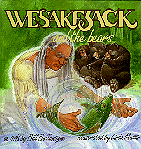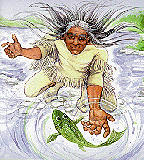

![]()

|
Wesakejack and the Bears.
Bill Ballantyne. Illustrated by Linda Mullin.
Preschool - Grade 3 / Ages 3 - 8.
**/4
|
excerpt:
Once long ago Wesakejack was travelling. He became hungry. [Peyakwaw kayas Wesakechak epapamoteyot ke atinotekatew.] He saw bears travelling toward the fishing rapids. Every year at this time there were many fish at the fishing rapids. Wesakejack hurried to get ahead of the bears and get his share of fish. By the time he got there the sun was going down. So Wesakejack had to wait until morning. When Wesakejack woke up the sun was shining. The bears began to arrive. When they saw Wesakejack, the bears stopped on top of the hill. They would wait for Wesakejack to get his fish.
 Bill Ballantyne is a Native story teller from Saskatchewan who moved to the
Brokenhead Reserve in Manitoba to teach grades two and three. This book,
the third in a series, reflects his championship of the Cree culture and
language -- he tells his tale in both English and Cree.
Bill Ballantyne is a Native story teller from Saskatchewan who moved to the
Brokenhead Reserve in Manitoba to teach grades two and three. This book,
the third in a series, reflects his championship of the Cree culture and
language -- he tells his tale in both English and Cree.

Recommended mainly for use in Cree-language situations.
Carol Carver is a Primary Teacher at École Dieppe School in Winnipeg.
To comment on this title or this review, send mail to cmeditor@mts.net.
![]()
Copyright © 1996 the Manitoba Library Association.
Reproduction for personal use is permitted only if this copyright notice
is maintained. Any other reproduction is prohibited without permission.
Published by
The Manitoba Library Association
ISSN 1201-9364
![]()